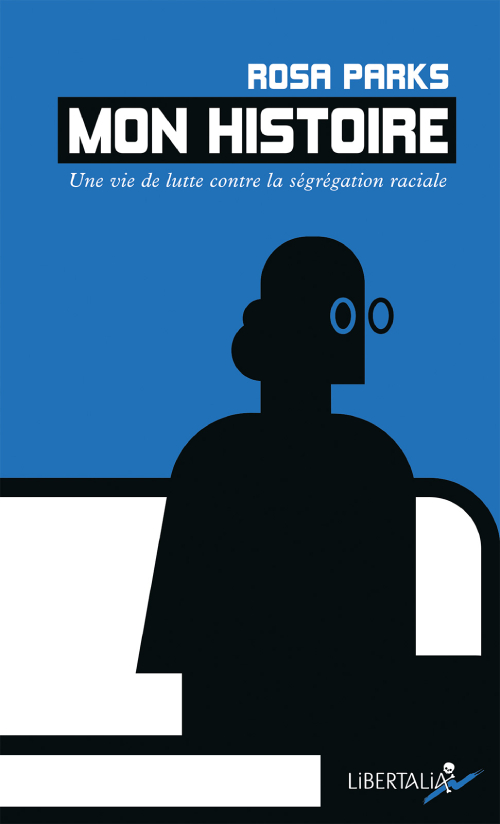My Story by Rosa Parks
This post has been published in 2019 and may contain incorrect information or opinions I no longer hold.
You probably know Rosa Parks, the civil rights activist who refused to give up her seat on a bus in Montgomery in 1955, triggering a boycott campaign that was decisive for the civils rights of black citizens in the United States.
But Rosa Parks did much more than just sit on a bus, and I invite you to discover this in her autobiography.

Rosa Parks (1913 – 2005) is one of the most emblematic figures in the fight for civil rights, but she is most often seen as incidental, as having had an influence almost in spite of herself. She is often portrayed as a tired old woman who finds herself embroiled in something much bigger than herself:
« People always say that I didn’t give up my seat because I was tired, but that isn’t true. I was not tired physically, or no more tired than I usually was at the end of a working day. I was not old, although some people have an image of me as being old then. I was forty-two. No, the only tired I was, was tired of giving in. »
On 1 December 1955, when she was arrested for refusing to give up her seat on a bus, Rosa Parks was already a seasoned activist. Alongside (and sometimes against the advice of) her husband Raymond Parks, a member of the NAACP [1], she took part in numerous actions. In particular, she was involved in the Voter's League, to help black citizens register to vote so that they could exercise their right to vote.
In the United States in the 1940s, in order to register to vote, black citizens had to take literacy tests. The offices where these tests were taken were only open for a few hours a week, which made access to them extremely difficult. What's more, the results of these tests are left to the discretion of the authorities, which do not need to justify any refusal. Finally, even when registration is accepted, the electoral card is sent by post and does not always arrive at its destination. Conversely, white citizens need only go to the polling station to collect their card in person, without a test. It was not until the Voting Rights Act signed by Lyndon Johnson in August 1965 that all discrimination against the right to vote of ‘racial minorities’ was abolished.
In the early 1950s, the NAACP was looking for a case to end segregation on buses. At the time, the front of buses was reserved exclusively for white passengers, even when the bus was empty, and black passengers were supposed to sit in the back rows or stand. What's more, when the bus is full, the rows usually reserved for black passengers have to be vacated for white passengers.
If a black passenger does not comply with these rules, they can be arrested. The NAACP's strategy is to find a victim among those arrested whose case can be brought before the Supreme Court to prove that segregation laws are unconstitutional. A young girl, Claudette Colvin, was arrested in March 1955, but when it was discovered that she was pregnant by an older married man, her case became indefensible.
Although her action was not premeditated, when Rosa Parks was incarcerated in December of the same year, she realised that she was the ideal person: married, educated, with a job and a good reputation, she could not be blamed for anything.

Rosa Parks with Martin Luther King, in 1955.
Rosa Parks worked hand in hand with Martin Luther King, who was only a young pastor in 1955. She was close to many of the leaders of the civil rights movement, and continued to work with them for many years.
In her autobiography, she talks at length about this well-known part of her life, but she also touches on her childhood and adolescence: this is a valuable account of the life of black Americans in the post-war southern states.
Rosa Parks writes very well, and I can only recommend that you read this autobiography, published in 1992 but previously unpublished in French, before Julien Bordier's translation in 2018 (!). At a time when questions are being asked about the creative liberties taken in telling the stories of people from minority groups [2] and about the relevance of telling stories about racism from the point of view of white people [3], I think it's vital to read texts written by the people concerned. It is important not to confiscate their voices, at the risk of having a biased story, even one rewritten to make the white people involved look like saviours.
This autobiography is a rare opportunity to discover the life of an important figure in American history, in her own words, her own narrative.
Footnote
[1] The National Association for the Advancement of Colored People was founded in 1909. Its mission is « to ensure equal political, educational, social and economic rights for all citizens and to eliminate racial hatred and discrimination ».
[2] For example, Bohemian Rhapsody, the biopic about Freddy Mercury.
[3] For example, The Help, Mr Church or Green Book, which has just won the Oscar for best film.

